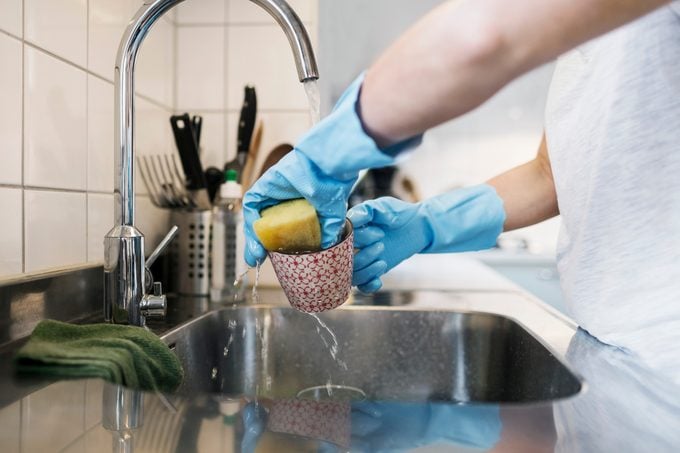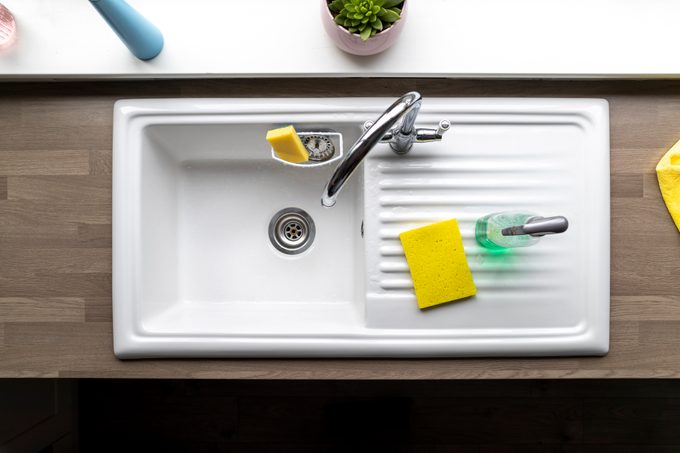This Is How Often You Should Replace Your Kitchen Sponge (And What Happens When You Don’t)
Updated: May 06, 2020
Replacing your kitchen sponge every week or two is the best way to prevent the spread of infection-causing bacteria and viruses.
Our editors and experts handpick every product we feature. We may earn a commission from your purchases.
When it comes to washing your dishes (sans dishwasher), you always make sure to have your two essentials: Dish soap and a kitchen sponge. While it’s important to clean your dishes, cutlery, kitchen gadgets, and cooking tools, it’s easy to overlook the grease and grime on that sponge. Think about it, when was the last time you replaced this tool? Last week? Three months ago?
Chances are you probably don’t replace your kitchen sponge as often as you should. And, as a result, it most likely contains bacteria, and you could be spreading illness-causing germs including E. coli, Salmonella, and maybe even SARS-CoV-2, the virus that causes Covid-19. (If you want to rid your house of the virus, here are 9 EPA-registered coronavirus cleaning products to try.)
The dirty truth is that sponges are about as germy as it can get. In fact, a study in the July 2017 issue of Scientific Reports suggests that kitchen sponges are germier than toilets. The researchers, including study author Markus Egert, PhD, professor for microbiology and hygiene at Furtwangen University in Schwenningen, Germany, noted there were 362 different kinds of bacteria found lurking in the crevices of sponges from homes. Approximately, 5.5 trillion microscopic bugs per kitchen sponge were found.
All sorts of creepy, crawly germs lurk in the crevices of kitchen sponges, explains Egert. We’re talking bacteria, archaea, fungi, protozoa, algae, and viruses. “But, bacteria are the most abundant,” he says.

A repository for germs
Sponges are the perfect repository for germs. “They are usually wet, stored in a warm place, have a huge surface, and contain many nutrients for microbes such as food residue and even dishwashing detergent,” he explains.
Bacteria don’t just survive; they also thrive in this environment and can spread to your countertop and dishes you think you’re cleaning, says Phillip Delekta, PhD, instructor in microbiology at Michigan State University in East Lansing. “Viruses like [SARS-CoV-2] wouldn’t multiply or stay there indefinitely, but they could survive and be spread during cleaning.” Here are 10 other things in your house that could be making you sick.
So, now that you know that your sponge will scoop up all sorts of bacteria, how often should you be replacing it?
When to replace your kitchen sponge
Replace your kitchen sponge every one to two weeks, Egert suggests. “In view of the trillions of germs inside a sponge, probably no domestic method will eradicate all of them, and after a few days or maybe even hours, the sponge is recolonized again.” It’s also time to trash your sponge if it starts to give off a sour, mildewy stench, adds Delekta. “If you have a sponge that gives off an odor and has visible growth and is clearly oiled—get rid of it,” he says. (Here are 15 other things you should replace more often.)
How to effectively clean it
If you want to clean your sponge, putting it into the washing machine at 60° C (140° F), and using a bleach-containing, heavy-duty detergent is probably the best method, Egert suggests. He points out that this combines high temperature, strong chemistry, mechanics, and a sufficient amount of time.
Meanwhile, Delekta suggests this method: “Lather it up with dish soap and rinse it with running water to flush the bacteria and viruses of the surface of the sponge, and then put it in the microwave on high for two minutes to kill any bacteria.”
The wet part is key because placing a dry sponge in the microwave could cause a fire, he warns.

Where and how to properly store it
Where and how you store your sponge in between cleanings also matters. “Keep it in a holster away from the faucet or drain to let it dry out,” Delekta adds. “The more it dries out the less likely it is to harbor bacteria and other germs.”
It’s also smart to use separate sponges for separate areas or items. “The sponge that you use to clean your dishes shouldn’t be the same one you use to clean the bathroom,” he says.
Also, don’t use your kitchen sponge to soak up blood from meat or poultry on the countertop–as this is an excellent way to encourage bacterial growth. Clean those areas with paper towels and disinfectant sprays, Delekta suggests.
Safer alternatives
There are alternatives to sponges that are less likely to provide a safe house for bacteria and viruses and will stand the test of time, says Jennifer J. Stagg, ND, naturopathic physician and medical director of Whole Health Wellness Center in Avon, Connecticut and author of The Bitter Prescription. “Silicone sponges and scrubbing brushes are less porous and the material doesn’t support a moist enough environment for bacterial growth,” she says. Dr. Stagg recommends the Kuhn Rikon brushes and scrubbers. “Some other options are microfiber dishcloths that should be washed in a washing machine on high heat after each use,” she says.
Next, read about the everyday items that are dirtier than a toilet seat.
